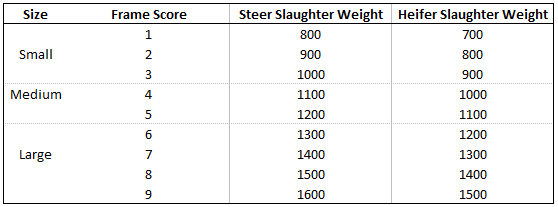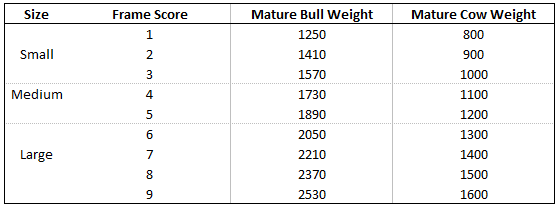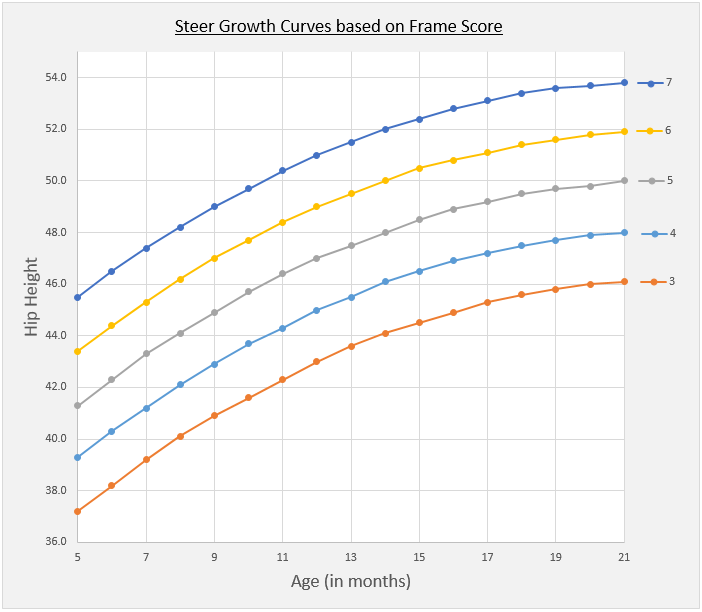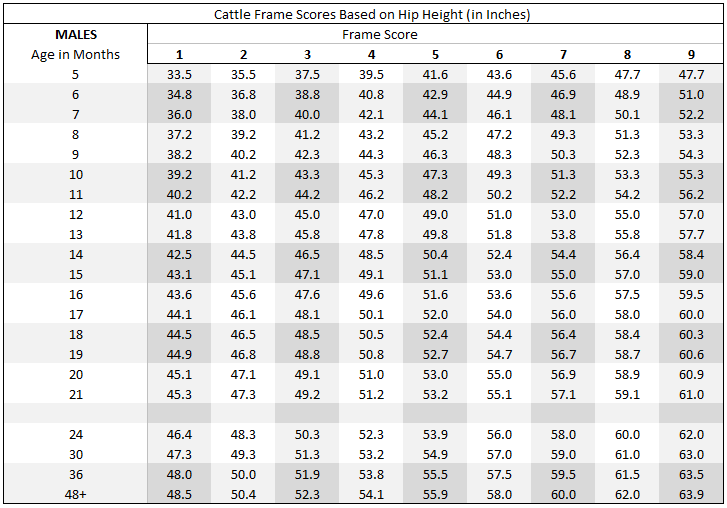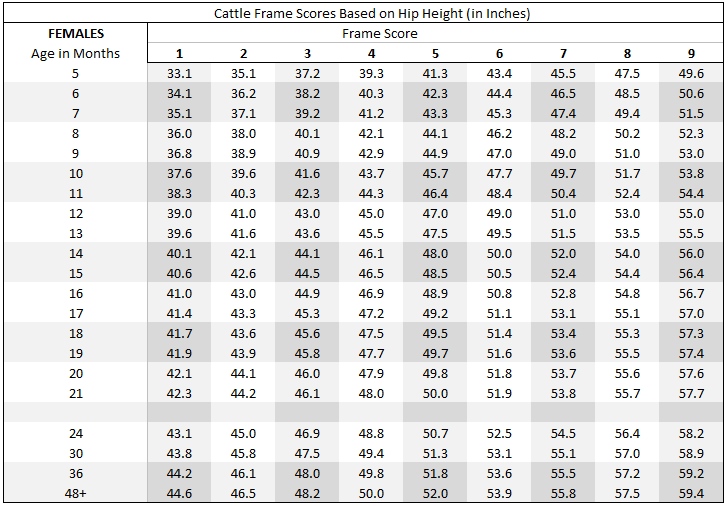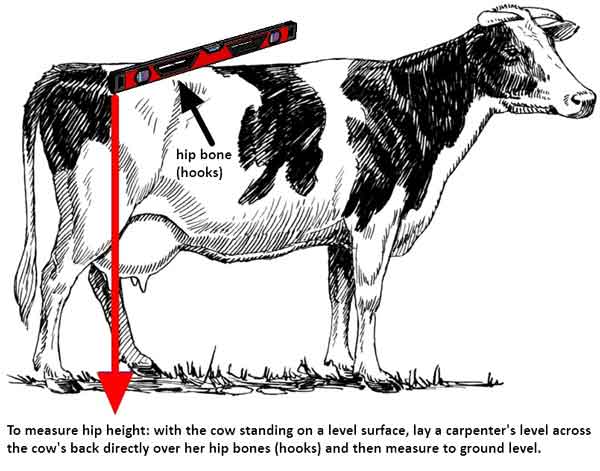Target slaughter weights:
Are your beef cattle fat enough when they go to market?
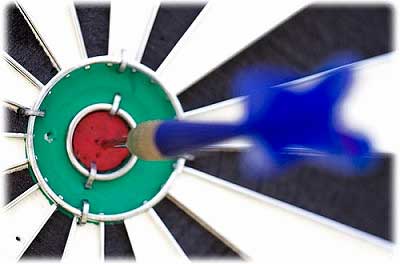
Image Credit: viZZZual.com, Flickr, CC BY 2.0
Beef cattle are considered finished and ready for slaughter when they have sufficient fat in their meat to make their beef tender and flavorful. Finishing cattle is all about the fat.
But how do you know when your beef cattle are fat enough?
In an ideal world you would be able to x-ray your live cattle to see, on a microscopic scale, when their beef has sufficient fat cells to make it tender and flavorful. Unfortunately that's not practical.
Luckily there is an easier way thanks to studies that correlate frame size (bone structure) and slaughter weight. In other words, you can figure out the ideal slaughter weight of your beef cattle simply by measuring their hip height and then using that measurement to look up the corresponding target slaughter weight on a table.
This simple technique allows you to know the ideal slaughter weight of every steer, heifer, cow or bull on your farm before you send them away to be slaughtered!
This technique is the core of every successful beef finishing operation, regardless of whether the cattle are finished on grass or on grain and regardless of whether the cattle are finished in a feedlot or out on wide open pastures.
In this article I explain exactly how to measure your cattle and I give you the look-up tables to find the target slaughter weight for every individual animal on your farm. And then I answer some important questions about how to integrate this technique into your cattle finishing strategy, both for grass finishing and grain finishing programs.
Frame scoring
Frame scoring is simply a way of categorizing beef cattle from smallest to largest based on their size (hip height). Frame scores are assigned on a scale from 1 to 9, with 1 being the smallest and 9 being the largest-framed cattle. There is a target slaughter weight corresponding to each frame score.
For example, a 9-month old steer with a hip height of 44.3 inches has a frame score of 4. This steer will be ready for slaughter when it reaches 1100 lbs. At 16 months this same steer will have a hip height of 49.6 inches, but its frame score (4) and target slaughter weight (1100 lbs) will still be the same.
By contrast, a 16-month old steer with a hip height of 55.6 inches will be categorized as a frame score of 7. It will therefore have a target slaughter weight of 1400 lbs.
And 16-month old heifer with hip height of 52.8 inches will also have a frame score of 7. Her target slaughter weight will be 1300 lbs (there are separate lookup tables for male and female cattle).
I think you see the pattern. While hip height changes with age, frame score generally does not. Combining hip height and age allows you to assign a specific frame score to any animal so you can know in advance, while it is still growing, what the target slaughter weight of that animal should be.
No more guessing. No more eye balling. You just measure your cattle and bingo, you know your target slaughter weights.
(Disclosure: I get commissions for purchases made using Amazon links in my post.)
With this technique, all you need is a simple cattle weigh scale to tell you if your cattle have reached their target slaughter weight and are ready to slaughter.
That's why the #1 tool you should own if you plan on finishing cattle for slaughter is a weigh scale. The easiest and cheapest solution is to mount a set of weigh bars under your cattle squeeze#CommissionsEarned, like the weigh bars shown in the image on the right, so you can weigh your cattle before you send them to the butcher.
Target Slaughter Weight by Frame Score
First, here are the target slaughter weights by frame score:
Now let's look at how to assign the correct frame score to your beef cattle:
How to convert hip height and age to frame score:
The simple premise behind frame scoring is that all beef cattle have a predictable growth curve.
The chart below shows how hip height changes among steers from 5 months to 21 months of age. There are 5 curves on the graph, one each for cattle with frame scores 3 through 7.
To find the frame score for any individual animal you simply find the intersection between hip height and age on the chart. Whichever growth curve this point is closest to, that is its frame score.
Cattle generally do not change frame scores in their lifetime. If a heifer has a frame score of 4 at seven months of age, she will still be a frame score of 4 when she reaches twenty one months of age, and she will continue to be a frame score of 4 to the day she dies of old age. That consistency is why we can predict target slaughter weights based on frame scores.
For ease of use these curves are generally turned into simple look-up tables, which are shown below. Male and female cattle have slightly different growth rates, which is why there are separate look-up tables for male and female cattle.
Frame score table for male cattle
Frame score table for female cattle
To use the tables to find the frame score of any individual animal in your herd, pick the row corresponding to its age (in months) and then slide across until you find its measured hip height (in inches). Then look at the top of that column to find its frame score number. That's the frame score number you use to look up target slaughter weight on the previous set of tables at the start of the article.
Technique for measuring hip height
To measure your cattle's hip height, simply lay a carpenter's level across their backs directly above their hip bones (hooks), then measure the distance down to ground level (the cattle must be standing on level ground).
The best time to take hip height measurements is whenever you already happen to have your cattle in the corral, such as on vaccination day.
Q&A about frame scores and target slaughter weights
And now for some answers to some commonly asked questions about how to apply this technique to your beef cattle finishing strategy:
Do grass finished and grain finished beef animals have the same target finishing weights?
Yes.
One of the biggest misconceptions about grass finishing is that there are different rules involved when finishing cattle on grass versus grain. There aren't.
Target slaughter weights don't change just because you change what the cattle eat. Nor will cattle be ready for slaughter just because it is autumn or just because the cattle have been on a finishing pasture or finishing ration for 60, 90, or 120 days. None of that matters.
Regardless of what the cattle are eating (grass-based vs grain-based finishing diet) or where they live (in a feedlot or out on open pasture), they still need to reach the same target weight, based on their height, in order to have sufficient muscle and fat and be tender and flavorful when they are slaughtered.
How long does it take to reach the target finished weight?
How rich is your pasture grass or feed ration? How many pounds will your cattle gain each day using your particular feeding or pasture management strategy? How many pounds do your cattle still need to gain between their current weight and their target finishing weight?
I have a wide range of frame scores in my cattle herd. How do I schedule my slaughter dates?
A wide range of frame scores means that you will have a slaughter season that stretches out over a long time, from the time the lightest cattle reach their target weight until the heaviest reach theirs, which can be many months later. When grass finishing in seasonal northern climates this can mean overwintering part of the herd to finish the larger-framed cattle the next season when the grass returns.
Larger feedlots tend to sort their calves on arrival to create groups of calves with the same age and frame size. This makes it easier for them to adjust feed rations as the calves grow since daily weight gains will be very similar for all calves in the same group. Each group is regularly weighed to monitor progress and slaughtered when the group reaches the target slaughter weight. This sorting allows the feedlot to schedule a single slaughter date for the entire group since all the calves in the group will presumably reach their target slaughter weight at roughly the same time.
Grass finishing programs, on the other hand, generally keep their cattle as a single large group (or in as few groups as possible) to make their pasture management simpler and more efficient. They have a strategy in place (i.e. alleyways in their pasture layout like those used by this example grass farm plan) to easily sort individual cattle out of the herd without having to bring the entire herd to the corral every time a few animals are ready to go to market.
(Disclosure: I get commissions for purchases made using Amazon links in my post.)
Weights can initially be eyeballed on pasture, but when the selected cattle reach the corral they should be measured and weighed on the cattle scale#CommissionEarned to be absolutely sure they have reached their target slaughter weight before getting loaded on the trucks to go to market.
Do all cattle from the same breed have the same frame score and target slaughter weight?
No.
Cattle from within the same breed tend to be similarly sized (it is unlikely that you will see a frame score of 2 and 8 in the same breed), but there will still be individual differences in height and thus a range of frame scores. That's why you have to get out and measure your herd.
Do I need to remeasure my herd every year?
Unless you change your cattle genetics, the range of frame scores (and the range of target finishing weights from smallest to largest) will remain very similar from year to year and you won't need to remeasure every year.
You'll know that your smallest cattle need to reach one weight, your largest cattle another, and the rest need to be somewhere in between.
But as soon as you introduce a different breed, you'll need to remeasure. You'll also need to remeasure every few years in case the genetics of your breeding stock starts to drift towards larger or smaller sizes (look at how much larger Black Angus cattle are now than they were 40 years ago!).
And if you have a mixed breed cattle herd, you'll want to re-measure even more frequently (possibly even annually) since the more breeds that contribute to your overall cattle herd, the more variation there will be in individual hip heights and frame scores!
And you should always remeasure if you make any large changes to your herd genetics, like if you add new bulls or replacement heifers from a different breed.
How exact is this technique?
It is an estimation technique.
Even after your beef cattle have reached their target weight, you still need to use your judgement to ensure that they look fat enough before sending them to slaughter.
One of the most useful tools to make that judgement is body condition scoring - a visual technique for judging cattle fatness - as a way to confirm that your cattle are fat enough to slaughter. Cattle should be between a body condition score of 5 and 7 before they go to slaughter, never less!
The closer the cattle are to a 7, the higher the beef will grade. But a BCS greater than 7 will be getting into obese territory. That extra fat is just going to be trimmed into the waste bin.
However, just remember that target slaughter weight comes before body condition. Your cattle are NOT ready to slaughter at a much lighter weight just because their body condition score is at a 7. But once they reach that slaughter weight (plus or minus a few pounds), then use your judgement of fatness (body condition scoring) to make that final decision of whether the cattle are ready to go to market.
What if my hip height measurement is somewhere between two frame scores?
Assign frame scores using halves, thirds, or quarters (whichever is your preference), and make the appropriate adjustments to the weights on the target slaughter weight by frame score tables.
Are frame scores relevant to all beef cattle breeds?
Yes.
Does the target finishing weight and frame score technique work for all cattle breeds?
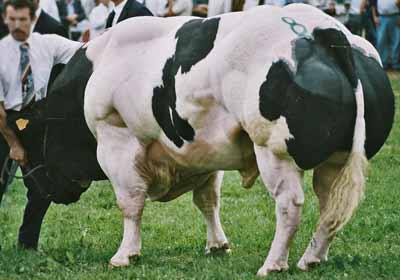 Belgian Blue Bull
Belgian Blue BullImage Credit: Mastiff, Wikimedia Commons, CC BY 2.0
Yes...
However there are a few rare exceptions such as the double-muscled cattle breeds like Belgian Blue and Piedmontese cattle. I think the photo on the right speaks for itself... If you have one of these breeds, ask your cattle breeder association to provide you with target finish weights for your cattle based on frame score.
Do frame scores change with age?
Frame scores generally remain the same throughout the cattle's lifetime, though this is not a guarantee.
This is why prudent cattle finishing operations always re-measure their cattle the very last time they weigh them before slaughter, even if they already have a frame score assignment from while the cattle were still younger.
Furthermore, some slow-growing cattle breeds do not follow the expected cattle growth curve, as is the case with some (but not all) Scottish Highland Cattle. Their frame score will change as they grow.
And an extreme food shortage can also temporarily stunt growth and throw growth curves out of whack.
Does the correlation between frame scoring and target slaughter weights also work for mature bulls and cows?
Yes. I have included the target slaughter weight look-up table for mature bulls and mature cows just below the table used for steers and heifers. And the frame score look-up tables for both male and female cattle extend right to mature body size.
Is frame score and target slaughter weight all it takes to ensure that beef is tender and flavorful?
No. Frame score and target slaughter weight is only one of the many criteria that you have to pay attention to in order to end up with tender and flavorful beef.
Some of the other details that you have to pay attention to in order to produce tender flavorful beef are:
- Cattle MUST be gaining weight right until the day they are slaughtered.
- Cattle must have consistent daily nutrition throughout the finishing process and must not be allowed to temporarily lose weight any time in the month or more before they are slaughtered, otherwise they will have insufficient microscopic intramuscular fat. Slaughtering either after the cattle run out of grass in the fall or during the winter when cattle are coasting along without weight gains won't work. As soon as cattle begin tapping their body fat reserves (even just a little bit) to make up for calorie shortfalls in their feed, their beef will be tough, dry, and flavorless even if their slaughter weight was on target. It can takes weeks or even months to refill those crucial fat reserves if weight gains temporarily stall or reverse.
- You must eliminate or minimize all sources of cattle stress both during the finishing process and on the way to the slaughterhouse. This includes handling stress, disease, environmental stress (i.e. heat stress, parasites, etc.), and nutritional stress (i.e. protein, energy, minerals, or vitamin deficiencies).
(Disclosure: I get commissions for purchases made using Amazon links in my post.)
- You can learn more strategies for producing tender, flavorful beef in my Seven Unbreakable Rules for Producing Great Beef article series and in the Grass Finishing chapter of my book, Grass Fed Cattle: how to produce and market natural beef#CommissionsEarned.
Summary
The correlation between hip height (frame score) and slaughter weight is one of the core pillars of any cattle finishing program, regardless of whether you are grass finishing or grain-finishing your cattle. It's a simple 1-2-3 process:
- Go measure your cattle's hip heights to find their frame scores.
- Use the lookup tables to find their target slaughter weights based on those frame scores.
- And weigh your cattle before you ship them to the slaughterhouse to make sure they have indeed reached their target slaughter weights.
If you make frame scores a central part of your cattle finishing strategy, you will be well on your way to producing consistent, tender, flavorful beef!
Share your cattle finishing tips!
Do you have any other cattle finishing tips that you use to ensure that your beef is tender and flavorful? Share them in the comments box below!
If you enjoyed this article, please use the "Like" buttons below to share it on social media. And if you'd like to be notified when I release future cattle farming articles, sign up for my free email notifications or follow me on Facebook or Twitter.


